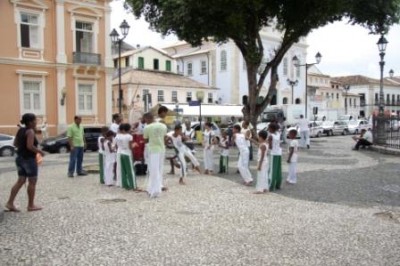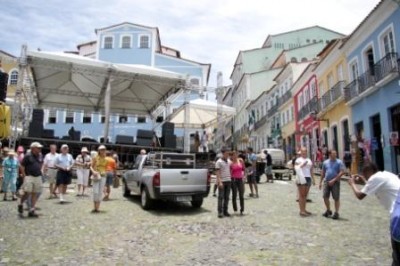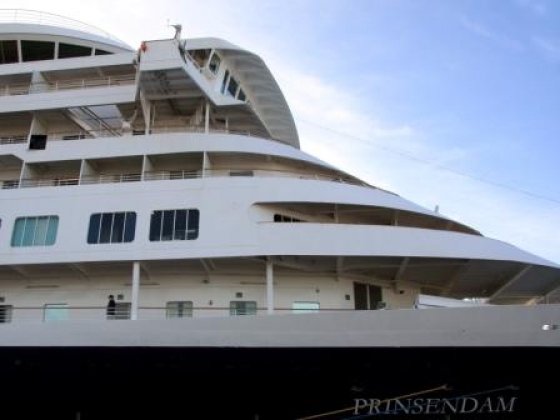Het was een verrassend beeld, dit Bahía in de ochtendglorierijke nevel. Maar noemt dit bruggenhoofd aan de baai wel Bahía?
Toch niet, voluit geschreven is het: Salvador da Bahía de Todos os Santos, en het wordt liefst in één woord uitgesproken! In feite probeert die naam de ganse voorgeschiedenis in één hap duidelijk te maken; je moet eerst wel veel adem gehapt hebben, of je komt er niet.
Het begint bij Amerigo Vespucci die in 1501 deze beschutte baai ontdekte, op 1 november. Omdat toen nog alle ontdekkingsreizigers katholiek waren, was het bijna heiligschennis als Allerheiligen niet in de naam vernoemd zou worden, dus: Bahía de Todos os Santos. In 1549 – men had reeds goud en diamant gevonden – installeerden de Portugezen een gouverneur en, omdat dit een zegen voor het land én voor de kolonisten was, werd de nederzetting inmiddels omgedoopt tot: Saõ Salvador da Bahía de Todos os Santos: Heilige Redder van de Baai van Allerheiligen. Een draak van een naam, maar duidelijk een compromis à la Belge avant la lettre. De zwarte slaven die naderhand in massa werden aangevoerd (de gevangen genomen Indianen waren niet sterk genoeg om in de mijnen te werken), zullen noch aan die Heilige Redder, noch aan ’s lands mineralen, veel plezier beleefd hebben.
Naar westerse normen is Bahía zonder meer de eerste (beschaafde?) “stad” op mijn reisroute. Alles wat je van een moderne stad verwacht is er aanwezig: hoge buildings, mooie gebouwen, transport infrastructuur, veel mensen op straat, een grote haven, veel toerisme, shopping plazas, zelfs een beurs. Uiteraard heeft Bahía ook vele Europese, zeg maar, kolonialistische trekjes. Ondertussen wonen er 3 miljoen mensen, waarvan een meerderheid zwarten. Volgens mij zaten die laatsten vooral op de bussen want die zagen zwart van het volk, terwijl ze in het gewone straatbeeld niet domineerden, voor zover men de toeristenprulletjesleurders buiten beschouwing laat. De laatste statistieken tonen aan dat het geboortecijfer sinds 1990 gedaald is van 8.8 kinderen per gezin naar 1.8, nog een beetje minder en het zijn eenzaten.
 Hoe dan ook, de stad bruist van leven, leven dat geflankeerd is door schitterende gebouwen. Opvallend in de reeks privé gebouwen zijn Amerikaanse, Duitse en Italiaanse pareltjes, samen met de residentie van de grootste slavenhandelaar. De oude, meestendeels Portugese paleizen dienen vandaag uiteraard voor de “poderes vigentes”, o.m. de residentie van de gouverneur van de staat (gewoon Bahía genoemd) zijn imposant, en prachtig gerestaureerd.
Hoe dan ook, de stad bruist van leven, leven dat geflankeerd is door schitterende gebouwen. Opvallend in de reeks privé gebouwen zijn Amerikaanse, Duitse en Italiaanse pareltjes, samen met de residentie van de grootste slavenhandelaar. De oude, meestendeels Portugese paleizen dienen vandaag uiteraard voor de “poderes vigentes”, o.m. de residentie van de gouverneur van de staat (gewoon Bahía genoemd) zijn imposant, en prachtig gerestaureerd.
Ander schouwspel zijn kerken en kloosters. De prachtigste bevinden zich in de bovenstad, de zgn. Pelourinho, wat “schandpaal” betekent. Op het centrale plein stond er inderdaad een schandpaal waar zwarte slaven werden afgeranseld. De kloosters van Susse & Trees zijn indrukwekkende architecturale sieraden. De kloosterkerk van de franciscanen wordt ook de “Gouden Kerk” genoemd, met recht en reden, want binnenin is alles verguld op enkel barokke beelden na.
 Omdat ze tot de andere heilige plaats geen toegang hadden, hebben de Afrikanen zelf ook een kleurrijke kerk gebouwd; pikant detail is dat er uitsluitend zwarte heiligen – eigenlijk witte heiligen zwart gemaakt (letterlijk) – de plak zwaaien. Zowel de schandpaal als de zwarte kerk staan op een pleintje waarrond de voorbereidingen voor Carnaval “in full swing” – beter, “in full samba” – waren. In Brazilië is Bahía wat dat betreft, en mede door de Afrikaanse invloeden, even beroemd als Rio. De stoet is naar verluidt 14 kilometer lang met ontelbare “floats” die … tussen de 8000 en 12000 dansers en muzikanten per stuk dragen!
Omdat ze tot de andere heilige plaats geen toegang hadden, hebben de Afrikanen zelf ook een kleurrijke kerk gebouwd; pikant detail is dat er uitsluitend zwarte heiligen – eigenlijk witte heiligen zwart gemaakt (letterlijk) – de plak zwaaien. Zowel de schandpaal als de zwarte kerk staan op een pleintje waarrond de voorbereidingen voor Carnaval “in full swing” – beter, “in full samba” – waren. In Brazilië is Bahía wat dat betreft, en mede door de Afrikaanse invloeden, even beroemd als Rio. De stoet is naar verluidt 14 kilometer lang met ontelbare “floats” die … tussen de 8000 en 12000 dansers en muzikanten per stuk dragen!
Ik kan SdBdToS aanbevelen, zeer zeker aan Belgische landgenoten. Immers het regent er elke dag – meestal ’s morgens, bij zonsopgang. Het ganse jaar door varieert de temperatuur tussen de 25° en de 28° in de schaduw, die zich doorgaans goed wegstopt. En dan zijn er nog de prachtige stranden, de baai zelf (zo groot als Vlaams-Brabant met ongehinderd zicht van Steenhuffel tot Tienen), de cacaobomen en –dranken, …. Bahia? Koel! Om niet te missen!!
Prinsendam, vrijdag 28 januari 2011
Baai, baai, Allerheiligste Aards Paradijs!

 All told, the city is buoyant with vivid life, a life that is lived in a breathtaking environment, created by nature as well as by architecture. Salvador boasts a remarkable number of private residences, including the splendid mansion of its biggest slave trader. The old, predominantly Portuguese palaces have been “redeployed” for use by the government. The residence of the governor of the state (simply called Bahía) is imposing and artfully restored. Its towering position, high above the city and the bay, leaves no doubt about where the boss lives.
All told, the city is buoyant with vivid life, a life that is lived in a breathtaking environment, created by nature as well as by architecture. Salvador boasts a remarkable number of private residences, including the splendid mansion of its biggest slave trader. The old, predominantly Portuguese palaces have been “redeployed” for use by the government. The residence of the governor of the state (simply called Bahía) is imposing and artfully restored. Its towering position, high above the city and the bay, leaves no doubt about where the boss lives.